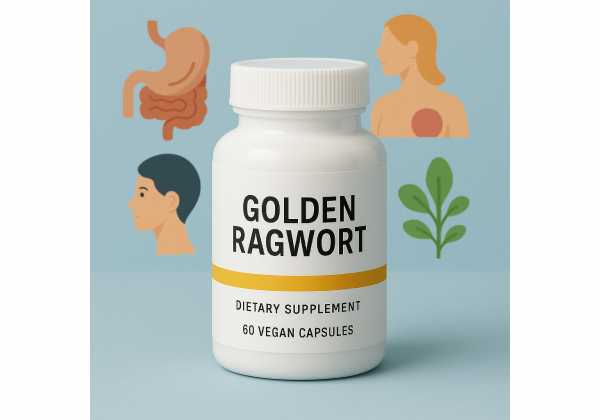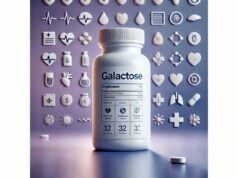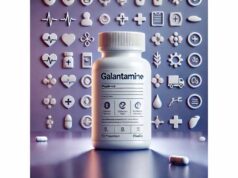
Golden ragwort (Packera aurea, formerly Senecio aureus) is a spring-blooming wildflower native to eastern North America. In folk medicine it was brewed or tinctured for menstrual discomfort, childbirth support, and minor wounds. Today it’s more often planted for pollinators than taken as a supplement—and for good reason. Like many members of the ragwort tribe (Senecioneae), golden ragwort naturally produces pyrrolizidine alkaloids (PAs), compounds linked to serious liver injury and other harms when ingested or absorbed over time. You’ll see capsules, teas, and tinctures online, sometimes labeled “PA-free,” but standards and testing can be inconsistent. This guide explains what golden ragwort is, what claims are made for it, why safety is the central issue, and what to consider if you still encounter it in the marketplace. You’ll also find practical alternatives with better evidence and safety profiles.
Key Insights
- Traditional uses focus on menstrual cramps and topical wound care, but modern evidence for benefits is limited.
- Golden ragwort contains pyrrolizidine alkaloids that can injure the liver and may be carcinogenic with chronic exposure.
- No established safe oral dose; regulatory contamination limits for total PAs are typically ≤1.0 µg/day, which is not a therapeutic dose.
- Avoid use in pregnancy, breastfeeding, children, and anyone with liver disease or who drinks alcohol heavily.
Table of Contents
- What is golden ragwort?
- Potential benefits and what to expect
- How people use it (and practical alternatives)
- Safe dosage: is there one?
- Side effects, interactions, and who should avoid
- Evidence, research quality, and bottom line
What is golden ragwort?
Golden ragwort (Packera aurea) is a herbaceous perennial in the aster family. It forms basal rosettes of rounded, heart-shaped leaves and sends up one to two-foot stalks that bloom bright yellow in early spring. Gardeners plant it as a native groundcover for moist woods and streambanks; bees and small flies use its pollen and nectar. Historically, North American tribes prepared teas or topical infusions from roots and leaves for gynecologic complaints, urinary discomfort, and minor skin issues. These uses were recorded long before modern toxicology identified a hard limit: many ragworts are chemically hazardous.
The concern centers on pyrrolizidine alkaloids (PAs)—plant defense molecules found across Senecio/Packera species and other genera. In the body, certain “1,2-unsaturated” PAs can be metabolized to reactive intermediates that damage liver blood vessels (leading to hepatic sinusoidal obstruction syndrome) and can form DNA adducts with long-term cancer risk. PAs vary by species, plant part, and season, but variability does not equal safety. Claims that golden ragwort is “milder” or “low-toxicity” typically rely on limited assays or older herbals rather than present-day exposure science. Even when total PA content appears low, repeated use can accumulate risk because the dose threshold for genotoxicity is extremely small.
Because of this chemistry, modern regulatory bodies treat intentional ingestion of PA-producing plants as unsafe. When you see “PA-free” on a label, that usually means the manufacturer asserts the PAs were removed or not detected to a certain analytical limit. However, analytical methods differ, dozens of PAs and their N-oxides exist, and batch-to-batch testing is not always transparent. In short: the plant’s biology and the toxicology drive cautious guidance.
If you’re here because of traditional claims—menstrual comfort, postpartum recovery, or “uterine tonic” effects—it’s important to separate legacy use from contemporary risk assessment. Safer herbs and non-herbal options now exist for the same goals with clearer evidence and far stronger safety margins. This doesn’t erase the plant’s ethnobotanical history, but it reframes its place in modern self-care: excellent for native plant gardens, poor fit for supplements.
Potential benefits and what to expect
Traditional claims. Golden ragwort appears in older North American herbals for dysmenorrhea (cramping), irregular menses, and as a childbirth aid. Topically, poultices and washes were used for minor sores. These claims stem from community practice rather than controlled clinical trials. Modern literature contains little to no robust human research specific to Packera aurea for these indications.
Possible mechanisms. Some ragworts show antispasmodic activity in lab models, plausibly explaining cramp relief. Antioxidant or anti-inflammatory signals occasionally appear in cell studies of related species. Yet these exploratory findings don’t overcome the high-priority safety issue posed by unsaturated PAs. In toxicology, “possible benefit” never substitutes for a well-defined risk–benefit profile.
What users typically report. Anecdotes describe short-term relief of menstrual cramps when used in blends. However, individual feedback is not a substitute for safety data. Because the active dose, if any, is unknown and the toxic dose can be low with repeated exposure, “it seems to help” is not sufficient justification for internal use.
Where benefits are more believable. If your goals are menstrual comfort or pelvic muscle relaxation, other approaches—heat therapy, magnesium (e.g., 200–400 mg elemental magnesium per day), NSAIDs as directed, or herbs with better safety profiles—are more appropriate. For minor skin issues, proven basics such as gentle cleansing, petrolatum-based occlusion, and proper wound care techniques are safer and better studied than PA-containing botanicals.
Expectations, realistically. If you avoid ingestion (the prudent choice), the only benefit golden ragwort reliably offers is ecological: early pollen and nectar for insects and an attractive native groundcover. As a supplement, any claimed systemic benefits are overshadowed by disproportionate risk. Even products advertised as “for topical use only” may still pose risk because PAs can be absorbed through the skin, particularly on damaged skin or with prolonged application.
Bottom line for “benefits.” When a plant’s hallmark chemistry is both hepatotoxic and genotoxic, the bar for clinical benefit must be high. Golden ragwort doesn’t clear that bar. Choose alternatives for health benefits and keep this plant where it shines—outdoors.
How people use it (and practical alternatives)
How it’s sold. You may encounter dried aerial parts for tea, alcohol tinctures, powdered capsules, or topical salves. Labels might highlight historic uses or claim “PA-free” status. “PA-free” is not a therapeutic validation; it’s a manufacturing claim about contaminant removal or non-detection at a lab’s limit of quantitation. Without standardized, independent verification for every batch and every PA/N-oxide variant, you can’t assume zero exposure.
Traditional preparations (for context, not recommendation).
- Tea/decoction: 1–2 g of dried herb simmered and drunk up to three times daily in historical texts. This is not recommended today because any unsaturated PA exposure accrues risk with repetition.
- Tincture: Historically, small volumes (e.g., 1–2 mL, 1–3×/day) were used by some practitioners. Again, not recommended.
- Topical washes/poultices: Applied to minor skin complaints. Even dermal routes can deliver PAs; avoid especially on broken skin or for prolonged use.
Why alternatives are preferable. For menstrual cramping, well-tolerated options include:
- Heat therapy: A heating pad or hot water bottle reduces pain by relaxing uterine muscle.
- Magnesium glycinate or citrate: Often 200–400 mg elemental magnesium daily with food.
- Cramp bark (Viburnum opulus) or ginger (Zingiber officinale): These have a stronger safety profile when used appropriately.
- Lifestyle steps: Hydration, gentle movement, and sleep support all modulate pain perception.
For general wound care: gentle cleansing, appropriate dressings, and letting minor injuries heal without irritants outperforms most old-style poultices.
If you still plan to use a product you found. Understand this is not advised. If you proceed against guidance:
- Choose PA-free, independently tested products with a current certificate of analysis (CoA) that lists the sum of 1,2-unsaturated PAs and their N-oxides.
- Avoid oral use entirely. Do not apply to broken skin; limit any intact-skin use to very short durations.
- Do not combine with alcohol or other liver-stressors.
- Stop and seek medical evaluation if you notice nausea, right-upper-quadrant pain, dark urine, jaundice, or unusual swelling.
Household safety. Keep the plant and any products away from children and pets. Many grazing animals are susceptible to PA poisoning; do not allow dried clippings into hay or compost destined for animal feed.
Regulatory view to keep in mind. When authorities set microgram-per-day caps for unintentional PA contamination of foods and herbal products, that’s a signal those compounds are not fit for intentional dosing. Treat claims that minimize this risk with skepticism.
Safe dosage: is there one?
Short answer: No. There is no established safe oral dose of golden ragwort because of its content of unsaturated pyrrolizidine alkaloids. Any oral exposure is avoidable risk.
About those microgram numbers you may see. Some authorities set very low contamination limits for the sum of PAs plus their N-oxides in herbal medicinal products and certain foods—typically around ≤1.0 µg/day for adults. These limits are designed to cap incidental exposure from products not supposed to contain PAs or from minor cross-contamination. They are not therapeutic dosing targets, and they do not mean that taking golden ragwort is safe.
Topical use. PAs can be absorbed through the skin, and absorption is higher on damaged or inflamed skin. Because topical exposure still contributes to total body burden, and because people often reapply salves repeatedly, routine dermal use is also discouraged. If a clinician recommends a PA-free botanical topical for a short-term purpose, use on intact skin only and for the shortest possible time.
Special populations. There is no safe exposure in pregnancy, breastfeeding, infants, or children. People with known or suspected liver disease, heavy alcohol use, viral hepatitis, or cholestatic conditions should avoid all PA sources, including contaminated foods. The same caution applies to those on hepatotoxic or CYP-modulating medications.
If you want a numeric guideline anyway. The only numbers worth repeating are the contamination caps described above (e.g., ≤1.0 µg/day total PAs), which reinforce that deliberate ingestion is inappropriate. Treat these as upper bounds to avoid, not as a dose to “use.”
Practical rule of thumb. If a product lists golden ragwort (or Senecio/Packera species) as an active oral ingredient, skip it. If it claims “PA-free” and you still consider topical use, require a recent, independent CoA, avoid broken skin, and limit duration to a few days at most.
Bottom line. Dose questions only arise for substances with a margin of safety. For golden ragwort, the margin for intentional human dosing isn’t there.
Side effects, interactions, and who should avoid
Likely and serious risks.
- Liver injury. Unsaturated PAs can cause hepatic sinusoidal obstruction syndrome (veno-occlusive disease), presenting with abdominal pain, hepatomegaly, ascites, jaundice, fatigue, and elevated liver enzymes. Onset may be delayed and can occur after repeated small exposures. Severe cases can lead to liver failure or death.
- Carcinogenicity concern. Genotoxic PA metabolites form DNA adducts; long-term cancer risk drives extremely low exposure thresholds and “as low as reasonably achievable” policy.
- Dermal exposure risk. PAs can be absorbed through skin; repeated application or use on damaged skin increases systemic exposure.
Common side effects reported with PA-containing herbs. Nausea, abdominal discomfort, poor appetite, and dark urine are warning signs; stop use and seek care.
Drug and alcohol interactions.
- Alcohol (ethanol) increases liver stress; avoid absolutely.
- Acetaminophen (paracetamol), methotrexate, isoniazid, valproate, and other hepatotoxic drugs raise risk when combined with any PA exposure.
- CYP inducers/inhibitors (e.g., rifampin, St. John’s wort, certain antifungals or macrolides) can alter PA bioactivation, unpredictably changing toxicity.
- Herbs with hepatotoxic signals (e.g., kava, high-dose green tea extract) should not be combined.
Who should avoid golden ragwort entirely.
- Pregnant or breastfeeding individuals.
- Infants and children.
- Anyone with liver disease, abnormal liver tests, or a history of hepatitis.
- People who drink alcohol regularly or heavily.
- Those on hepatotoxic medications or significant polypharmacy.
Accidental exposure advice. If you drank a tea or took capsules and develop right-upper-quadrant pain, nausea, dark urine, swelling, or jaundice, seek urgent medical evaluation and tell clinicians about possible PA exposure.
Environmental and pet considerations. Ragworts can poison grazing animals; keep pets away from fresh or dried plant material and don’t compost trimmings where animals might access them.
Perspective check. When a plant’s risk is defined by micrograms per day of a known genotoxic group, the safest strategy is avoidance—not hedging with “small” amounts.
Evidence, research quality, and bottom line
Human data for golden ragwort itself. There are no high-quality randomized trials assessing Packera aurea for menstrual or gynecologic outcomes. Historical reports and practitioner anecdotes don’t meet modern evidence standards, especially against a backdrop of known class toxicity.
Evidence for the risk. The literature on unsaturated pyrrolizidine alkaloids is extensive: toxicology characterizes hepatic injury mechanisms; public-health surveillance has documented outbreaks and individual cases of veno-occlusive disease from teas and remedies made with PA-containing species; and regulatory science has set stringent exposure caps for contamination, not use. Risk assessment consistently labels PA exposure as a long-term concern, particularly for frequent consumers of herbal infusions and supplements.
Analytical realities. PAs come in many structural variants and N-oxides. Detection requires validated LC-MS/MS or HRMS methods, and laboratories must quantify the sum of relevant PAs/N-oxides at very low limits (often in the single-digit ng/g range). “Not detected” on a label might reflect a limited PA panel or higher detection limits. Batch variability further complicates assurance.
Species identification issues. The aster family includes many look-alikes. Misidentification or co-harvesting with other PA-producing weeds can contaminate otherwise non-PA plants. Even within Packera/Senecio, PA content varies by plant part and season. This ecological noise is exactly why regulators set exposure caps and why relying on tradition alone is risky.
Risk–benefit synthesis. To recommend an herb, you want: a plausible mechanism, consistent clinical benefit, and a wide safety margin. Golden ragwort lacks clinical trials and has a narrow-to-nonexistent margin for safe intentional dosing. In this calculus, avoidance is not alarmism—it’s standard risk management.
What to do instead.
- For menstrual cramps: topical heat, magnesium (200–400 mg elemental/day, with food), appropriate NSAIDs, and, when desired, evidence-informed botanicals with better safety records.
- For minor skin concerns: modern wound care basics and, when needed, clinician-directed treatments.
Final takeaway. Enjoy golden ragwort in the garden and in field guides. For supplements, choose options with clear human data and safe exposure margins. That’s the people-first approach.
References
- Use of herbal medicinal products containing toxic, unsaturated pyrrolizidine alkaloids (PAs) – Scientific guideline 2021 (Guideline)
- Risks for human health related to the presence of pyrrolizidine alkaloids in honey, tea, herbal infusions and food supplements 2017 (Systematic Risk Assessment)
- Pyrrolizidine Alkaloids in Foods, Herbal Drugs, and Food Supplements: Chemistry, Metabolism, Toxicological Significance, Analytical Methods, Occurrence, and Challenges for Future 2024 (Systematic Review)
- Hepatic veno-occlusive disease due to pyrrolizidine (Senecio) poisoning in Arizona 1977 (Case Report)
- Golden Ragwort 2008 (Government Fact Sheet)
Disclaimer
This guide is for educational purposes and is not a substitute for personalized medical advice, diagnosis, or treatment. Always speak with a qualified healthcare professional before starting, stopping, or changing any supplement or medication—especially if you are pregnant, breastfeeding, managing a medical condition, or taking prescription drugs. If you suspect exposure to pyrrolizidine alkaloids or experience symptoms of liver injury (such as abdominal pain, dark urine, or jaundice), seek medical care promptly.
If you found this article useful, consider sharing it on Facebook, X (formerly Twitter), or your favorite platform, and follow us for future updates. Your support helps us keep creating careful, people-first health content.










